SPORTS YOKOHAMA Vol.25:Feature03
![]()
Lifesaving is a sport that is built around the elements required for lifesaving efforts with the aim of improving lifesaving skills for drowning incidents. Rules are also based on actual lifesaving activities, and competitors are disqualified for violating any of these rules because such violations would be fatal to human lives. Training for lifesaving competitions is equivalent to honing lifesaving skills. A competition typically consists of 16 events of the ocean category (12 surf events and 4 beach events) and 10 events of the pool category. Some of the events are explained below.
Beach Flags [Ocean Category, Beach Event]
The competitors lie facing away with their face down from a series of beach flags (batons) stuck into the sand that are 20 meters away and fewer than the number of competitors. The game is played by the competitors racing to the flags and trying to grab one. The event tests reflexes, judgment and sprint ability.
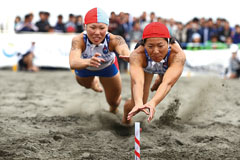
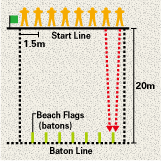
Board Rescue [Ocean Category, Surf Event]
A member of the team who plays the role of a drowning person swims 120 meters offshore, and then a second member of the team swims on a paddle board to the rescue and paddles back to the shore with the first member. The event tests the competitor’s abilities to ensure the safety of a drowning person and to recognize the signs of such a person.
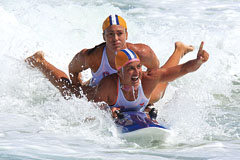
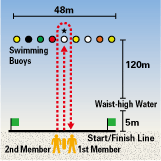
50-meter Mannequin Carry [Pool Category]
The competitor swims 25 meters, dives to recover a mannequin submerged at the center of the pool and then swims back another 25 meters carrying the mannequin.
Because the mannequin is used as a substitute for a drowning person, the competitor is disqualified for treating the mannequin improperly.
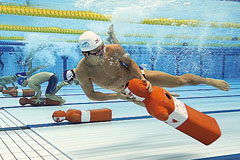
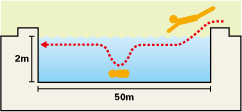
CPR Contest
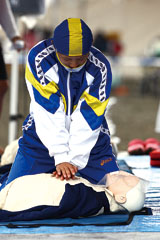 This contest evaluates the participants on their ability to properly perform artificial respiration and cardiac compression using a cardiopulmonary resuscitation (CPR) mannequin.
This contest evaluates the participants on their ability to properly perform artificial respiration and cardiac compression using a cardiopulmonary resuscitation (CPR) mannequin.
Not only should lifesavers be capable of running and swimming, but it is also important for them to have CPR skills.
The participants are rated on a three-point scale with regard to three evaluation criteria: Whether they precisely follow the first aid flowchart (see page 9); Whether they perform appropriate procedures for the securing of the airway, artificial respiration and breastbone compression (cardiac compression); and Whether they properly handle the automated external defibrillator (AED).
![]()
Lifesaving is a sport that is built around the elements required for lifesaving efforts with the aim of improving lifesaving skills for drowning incidents. Rules are also based on actual lifesaving activities, and competitors are disqualified for violating any of these rules because such violations would be fatal to human lives. Training for lifesaving competitions is equivalent to honing lifesaving skills. A competition typically consists of 16 events of the ocean category (12 surf events and 4 beach events) and 10 events of the pool category. Some of the events are explained below.
Beach Flags [Ocean Category, Beach Event]
The competitors lie facing away with their face down from a series of beach flags (batons) stuck into the sand that are 20 meters away and fewer than the number of competitors. The game is played by the competitors racing to the flags and trying to grab one. The event tests reflexes, judgment and sprint ability.


Board Rescue [Ocean Category, Surf Event]
A member of the team who plays the role of a drowning person swims 120 meters offshore, and then a second member of the team swims on a paddle board to the rescue and paddles back to the shore with the first member. The event tests the competitor’s abilities to ensure the safety of a drowning person and to recognize the signs of such a person.


50-meter Mannequin Carry [Pool Category]
The competitor swims 25 meters, dives to recover a mannequin submerged at the center of the pool and then swims back another 25 meters carrying the mannequin.
Because the mannequin is used as a substitute for a drowning person, the competitor is disqualified for treating the mannequin improperly.


CPR Contest
 This contest evaluates the participants on their ability to properly perform artificial respiration and cardiac compression using a cardiopulmonary resuscitation (CPR) mannequin.
This contest evaluates the participants on their ability to properly perform artificial respiration and cardiac compression using a cardiopulmonary resuscitation (CPR) mannequin.
Not only should lifesavers be capable of running and swimming, but it is also important for them to have CPR skills.
The participants are rated on a three-point scale with regard to three evaluation criteria: Whether they precisely follow the first aid flowchart (see page 9); Whether they perform appropriate procedures for the securing of the airway, artificial respiration and breastbone compression (cardiac compression); and Whether they properly handle the automated external defibrillator (AED).
 ハマスポ
ハマスポ
 お知らせ&トピックス
お知らせ&トピックス ページトップへ戻る
ページトップへ戻る ページトップへ戻る
ページトップへ戻る

